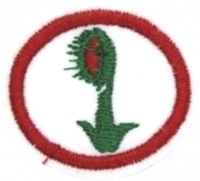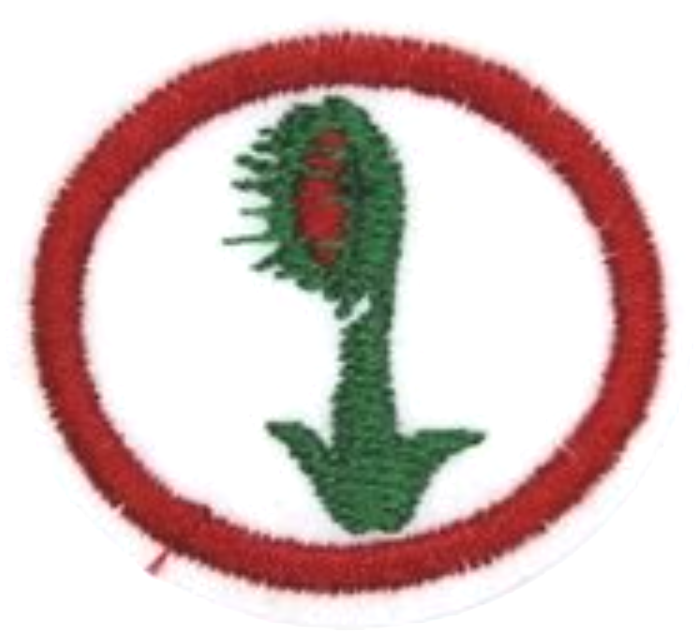Difference between revisions of "AY Honors/Carnivorous Plants/Answer Key"
From Pathfinder Wiki
< AY Honors | Carnivorous PlantsAY Honors/Carnivorous Plants/Answer Key
(Marked this version for translation) |
m (- Category of AYHAB) |
||
| (7 intermediate revisions by 2 users not shown) | |||
| Line 1: | Line 1: | ||
| − | < | + | {{HonorSubpage}} |
| − | <noinclude><translate><!--T: | + | <section begin="Body" /> |
| + | {{ansreq|page={{#titleparts:{{PAGENAME}}|2|1}}|num=1}} | ||
| + | <noinclude><translate><!--T:21--> | ||
</noinclude> | </noinclude> | ||
| − | + | <!-- 1. What are the characteristics of a carnivorous plant that differ from normal plants? --> | |
| − | |||
| − | |||
| − | |||
| − | |||
| − | |||
| − | |||
| − | |||
| − | |||
| − | == | + | <!--T:22--> |
| + | <noinclude></translate></noinclude> | ||
| + | {{CloseReq}} <!-- 1 --> | ||
| + | {{ansreq|page={{#titleparts:{{PAGENAME}}|2|1}}|num=2}} | ||
| + | <noinclude><translate><!--T:23--> | ||
| + | </noinclude> | ||
| + | <!-- 2. What special precautions are to be taken in the care and conservation of carnivorous plants? --> | ||
| − | = | + | <!--T:24--> |
| + | <noinclude></translate></noinclude> | ||
| + | {{CloseReq}} <!-- 2 --> | ||
| + | {{ansreq|page={{#titleparts:{{PAGENAME}}|2|1}}|num=3}} | ||
| + | <noinclude><translate><!--T:25--> | ||
| + | </noinclude> | ||
| + | <!-- 3. Conduct research and establish the relationship between: flowers of carnivorous plants, the process of pollination and insects on which they feed. --> | ||
| − | == | + | <!--T:26--> |
| + | <noinclude></translate></noinclude> | ||
| + | {{CloseReq}} <!-- 3 --> | ||
| + | {{ansreq|page={{#titleparts:{{PAGENAME}}|2|1}}|num=4}} | ||
| + | <noinclude><translate><!--T:27--> | ||
| + | </noinclude> | ||
| + | <!-- 4. Describe the characteristics of the following four main families of carnivorous plants, describing their species, names of some examples, origin, and characteristics that define them: --> | ||
| − | == | + | <!--T:28--> |
| + | <noinclude></translate></noinclude> | ||
| + | {{ansreq|page={{#titleparts:{{PAGENAME}}|2|1}}|num=4a}} <!--T:6--> | ||
| + | <noinclude><translate><!--T:29--> | ||
| + | </noinclude> | ||
| − | == | + | <!--T:30--> |
| + | <noinclude></translate></noinclude> | ||
| + | {{CloseReq}} <!-- 4a --> | ||
| + | {{ansreq|page={{#titleparts:{{PAGENAME}}|2|1}}|num=4b}} <!--T:7--> | ||
| + | <noinclude><translate><!--T:31--> | ||
| + | </noinclude> | ||
| − | == | + | <!--T:32--> |
| + | <noinclude></translate></noinclude> | ||
| + | {{CloseReq}} <!-- 4b --> | ||
| + | {{ansreq|page={{#titleparts:{{PAGENAME}}|2|1}}|num=4c}} <!--T:8--> | ||
| + | <noinclude><translate><!--T:33--> | ||
| + | </noinclude> | ||
| − | == | + | <!--T:34--> |
| + | <noinclude></translate></noinclude> | ||
| + | {{CloseReq}} <!-- 4c --> | ||
| + | {{ansreq|page={{#titleparts:{{PAGENAME}}|2|1}}|num=4d}} <!--T:9--> | ||
| + | <noinclude><translate><!--T:35--> | ||
| + | </noinclude> | ||
| − | == | + | <!--T:36--> |
| + | <noinclude></translate></noinclude> | ||
| + | {{CloseReq}} <!-- 4d --> | ||
| + | {{CloseReq}} <!-- 4 --> | ||
| + | {{ansreq|page={{#titleparts:{{PAGENAME}}|2|1}}|num=5}} | ||
| + | <noinclude><translate><!--T:37--> | ||
| + | </noinclude> | ||
| + | <!-- 5. An interesting mechanism is how they use their traps to catch prey. Describe each one, identifying the species mentioned in the previous requirement: --> | ||
| + | |||
| + | <!--T:38--> | ||
| + | <noinclude></translate></noinclude> | ||
| + | {{ansreq|page={{#titleparts:{{PAGENAME}}|2|1}}|num=5a}} <!--T:11--> | ||
| + | <noinclude><translate><!--T:39--> | ||
| + | </noinclude> | ||
| − | == | + | <!--T:40--> |
| + | <noinclude></translate></noinclude> | ||
| + | {{CloseReq}} <!-- 5a --> | ||
| + | {{ansreq|page={{#titleparts:{{PAGENAME}}|2|1}}|num=5b}} <!--T:12--> | ||
| + | <noinclude><translate><!--T:41--> | ||
| + | </noinclude> | ||
| − | == | + | <!--T:42--> |
| + | <noinclude></translate></noinclude> | ||
| + | {{CloseReq}} <!-- 5b --> | ||
| + | {{ansreq|page={{#titleparts:{{PAGENAME}}|2|1}}|num=5c}} <!--T:13--> | ||
| + | <noinclude><translate><!--T:43--> | ||
| + | </noinclude> | ||
| − | == | + | <!--T:44--> |
| + | <noinclude></translate></noinclude> | ||
| + | {{CloseReq}} <!-- 5c --> | ||
| + | {{ansreq|page={{#titleparts:{{PAGENAME}}|2|1}}|num=5d}} | ||
| + | <noinclude><translate><!--T:57--> | ||
| + | </noinclude> | ||
| − | + | <!--T:58--> | |
| + | <noinclude></translate></noinclude> | ||
| + | {{CloseReq}} <!-- 5d --> | ||
| − | == | + | {{ansreq|page={{#titleparts:{{PAGENAME}}|2|1}}|num=5e}} <!--T:14--> |
| + | <noinclude><translate><!--T:45--> | ||
| + | </noinclude> | ||
| − | ==6. What is the process of "digestion" like in these plants and how do they get the necessary nutrients from the insects? | + | <!--T:46--> |
| + | <noinclude></translate></noinclude> | ||
| + | {{CloseReq}} <!-- 5e --> | ||
| + | {{CloseReq}} <!-- 5 --> | ||
| + | {{ansreq|page={{#titleparts:{{PAGENAME}}|2|1}}|num=6}} | ||
| + | <noinclude><translate><!--T:47--> | ||
| + | </noinclude> | ||
| + | <!-- 6. What is the process of "digestion" like in these plants and how do they get the necessary nutrients from the insects? --> | ||
| − | ==7. Do one of the following activities: | + | <!--T:48--> |
| + | <noinclude></translate></noinclude> | ||
| + | {{CloseReq}} <!-- 6 --> | ||
| + | {{ansreq|page={{#titleparts:{{PAGENAME}}|2|1}}|num=7}} | ||
| + | <noinclude><translate><!--T:49--> | ||
| + | </noinclude> | ||
| + | <!-- 7. Do one of the following activities: --> | ||
| − | == | + | <!--T:50--> |
| + | <noinclude></translate></noinclude> | ||
| + | {{ansreq|page={{#titleparts:{{PAGENAME}}|2|1}}|num=7a}} <!--T:17--> | ||
| + | <noinclude><translate><!--T:51--> | ||
| + | </noinclude> | ||
| − | == | + | <!--T:52--> |
| + | <noinclude></translate></noinclude> | ||
| + | {{CloseReq}} <!-- 7a --> | ||
| + | {{ansreq|page={{#titleparts:{{PAGENAME}}|2|1}}|num=7b}} <!--T:18--> | ||
| + | <noinclude><translate><!--T:53--> | ||
| + | </noinclude> | ||
| − | == | + | <!--T:54--> |
| + | <noinclude></translate></noinclude> | ||
| + | {{CloseReq}} <!-- 7b --> | ||
| + | {{ansreq|page={{#titleparts:{{PAGENAME}}|2|1}}|num=7c}} <!--T:19--> | ||
| + | <noinclude><translate><!--T:55--> | ||
| + | </noinclude> | ||
| + | <!--T:56--> | ||
| + | <noinclude></translate></noinclude> | ||
| + | {{CloseReq}} <!-- 7c --> | ||
| + | {{CloseReq}} <!-- 7 --> | ||
| + | <noinclude><translate></noinclude> | ||
==References== <!--T:20--> | ==References== <!--T:20--> | ||
| − | |||
<noinclude></translate></noinclude> | <noinclude></translate></noinclude> | ||
| + | {{CloseHonorPage}} | ||
Latest revision as of 21:56, 13 July 2022
Carnivorous Plants
Skill Level
1
Year
2012
Version
21.12.2025
Approval authority
South American Division
1
What are the characteristics of a carnivorous plant that differ from normal plants?
2
What special precautions are to be taken in the care and conservation of carnivorous plants?
3
Conduct research and establish the relationship between: flowers of carnivorous plants, the process of pollination and insects on which they feed.
4
Describe the characteristics of the following four main families of carnivorous plants, describing their species, names of some examples, origin, and characteristics that define them:
4a
Nepenthaceae
4b
Sarraceniaceae
4c
Droseraceae
4d
Lentibulariaceae
5
An interesting mechanism is how they use their traps to catch prey. Describe each one, identifying the species mentioned in the previous requirement:
5a
Cage traps
5b
Suction traps
5c
Sticky leaves
5d
Acid
5e
Other forms
6
What is the process of "digestion" like in these plants and how do they get the necessary nutrients from the insects?
7
Do one of the following activities:
7a
Have a duly cataloged collection of three different (natural) species, stating for each one the common name, scientific name, family and other details about the species.
7b
Assemble a photo album of at least 15 different species and state the common name, scientific name, family and other details about each species. These can be cataloged in digital form (slideshow) or on paper.
7c
Grow and care for a carnivorous plant of any species for three months and make a report indicating how to daily care for it.



